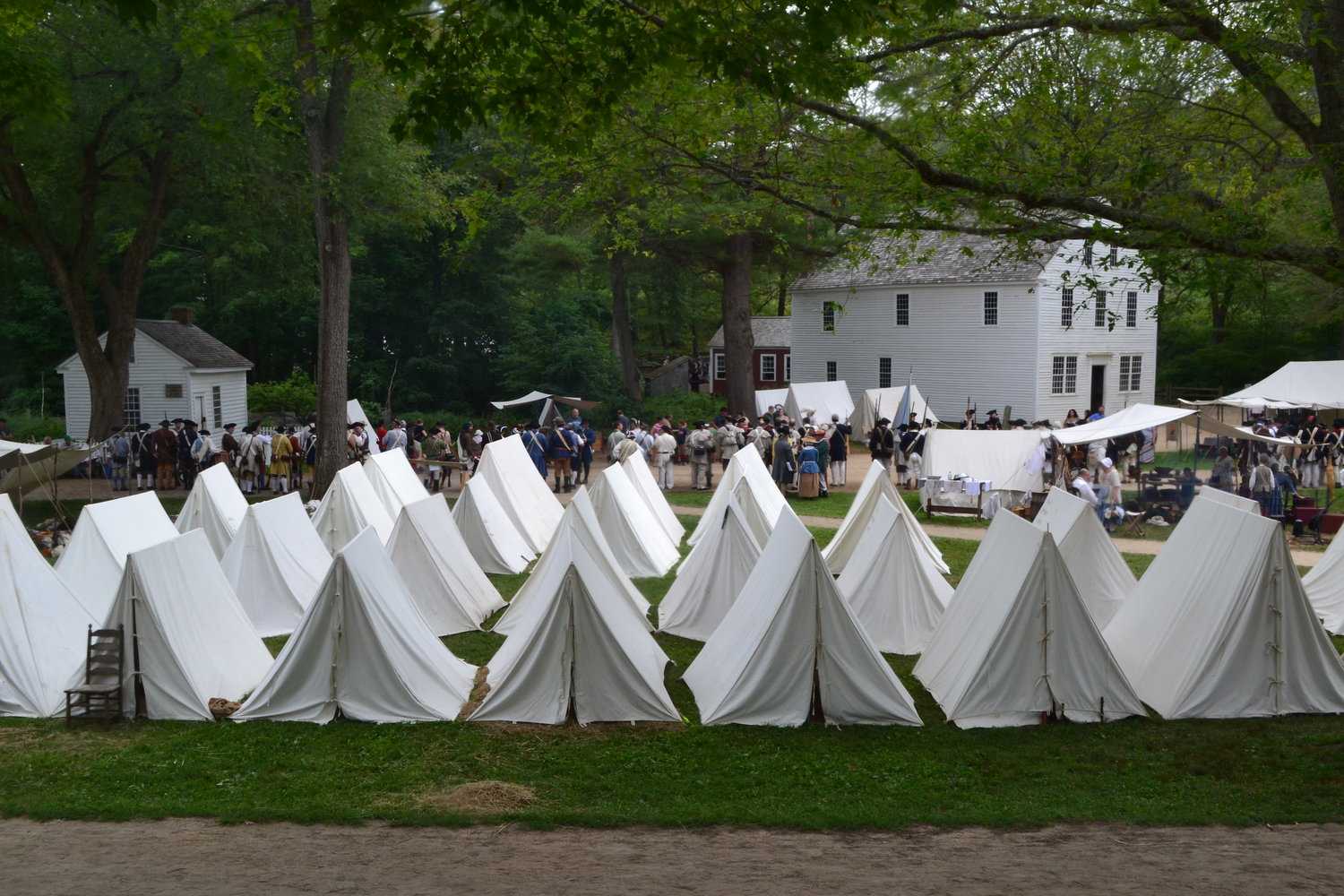It is a truth universally acknowledged that reenactments are the absolute best. What is not so commonly known is that a reenactment hosted at a historic village is pretty great too.

Such is Redcoats and Rebels at Old Sturbridge Village, a living history museum portraying life in rural New England from 1790 to 1840 playing host to a Revolutionary War reenactment one muggy Massachusetts weekend in August.
Old Sturbridge Village (OSV) proper was founded in 1936 by Albert B. Wells and his family. The 150 acre property purchased by Wells originally belonged to the Wight family, who lived and worked there since the 1700s; their original 1783 house and two early nineteenth-century farm buildings stood on the site. Moving at least six historical buildings on the property by 1941, Wells opened Old Sturbridge Village to the public on June 8, 1946. OSV is now one of the oldest and largest living history museums in the United States: Scattered throughout its 200 acres are more than sixty original and reproduction buildings and 60,000 early New England antiques, along with costumed interpreters demonstrating trades, cooking, gardening, and farming.
Thirteen years ago, OSV decided to host an event that is not primarily of its time period. They wanted a reenactment from a well-known war (which automatically rules out the War of 1812, to my everlasting sadness), ultimately choosing the Revolutionary War over the Civil War. The reasoning, according to Jim Obrien, director of public events, was twofold: First, it would be easier for the 1830s site to look back to the 1770s rather than forward to the 1860s, and second, the site’s New England location meant that its resident’s lives were more affected by Revolution than by the Civil War. Over the years, the event slowly grew to its present size, consisting of one thousand reenactors arriving by invitation only. Once on site, the reenactors portray more than just war, with little everyday things going on as well. I had the extreme pleasure of experiencing both [August 2016], in addition to what Old Sturbridge Village has to offer.

Arriving bright and early (for us), my parents, youngest sister Lydia, and I were in time for the 11:30 event “Shifts, Stays, & Panniers – what a woman wears!” going on in the Center Meetinghouse. Today’s events began at 9:30 for the early birds among us, and picking up an event schedule with a snazzy map on the back was an absolute must due to the sheer size of the place.
The ladies of “Shifts, Stays, & Panniers” went through typical 1770s women’s dress, both for the upper and lower classes, using themselves as models. Penny began the talk as a member of the lower class and ended in the guise of an upper class woman on her way to a ball. The undergarment stage was, shall we say, quite scandalous, as several of the reenactors in the audience made clear to the non-reenactor audience’s delight. Of course, Penny was wearing more undergarments than most people in the audience were wearing as street clothes, so the scandal-meter definitely operates on a sliding scale.

After “Shifts & Stays” I wandered the site, going counter-clockwise from the Center Meetinghouse, originally built in 1832 as the Baptist Meetinghouse in historic Sturbridge, Massachusetts. It was an interesting juxtaposition, the 1830s houses staffed with period-appropriate interpreters interspersed with the tents and reenactors dressed as if from the 1770s.



From the Meetinghouse it’s a very short walk to the Asa Knight Store. Originally a modest one-story building from 1810, it grew into a two-and-a-half story structure by 1838. Extensive research into original inventories provided the sources for the items lining the shelves, many of which are originals, with the exception of the textiles and more biodegradable foodstuffs. Both the Center Meetinghouse and the Asa Knight Store are located around the Common, which is handy to know when trying to navigate around the vast expanse that is Old Sturbridge Village.
OSV’s 200 acres is divided into four themes: The Common and the Center Village, Life in the Countryside, the Mill Neighborhood, and the Museum Exhibits and the Herb Garden. The Center Village and the Common illustrate the beginnings of a genteel taste in early nineteenth century America. Dominated by the Meetinghouse, the area consists of houses, workshops, and businesses. Most of the houses are on small lots with outbuildings, gardens, and a few livestock.

In contrast to the manicured elegance (for the time period, at least) of the Common and Center Village is the Countryside, illustrating a typical New England town of some 250 farms spread across the land. Occasionally there were clusters of houses, farms, and shops making up small settlements and agricultural neighborhoods. The “Country Walk” or “Farm Walk” takes one up and around farm houses, a school house, and various shops, including those of a blacksmith, cooper, and potter.
The pottery shop of Goshen, Connecticut, ca. 1819, was impressive based on the sheer number of pots and clay things they managed to cram into one building, as well as being one of the area’s few remaining original buildings constructed for making and firing redware pottery.


Another fun group of Countryside structures (and 2:00 host of the “Battle Between Patriots & Redcoats) is the Freeman Farm of Sturbridge, Massachusetts, ca. 1808, consisting of house, barn, and garden. Pliny Freeman and his family lived in this home in the early 1800s. The barn was built around 1830 to 1850 in Charlton, Massachusetts.
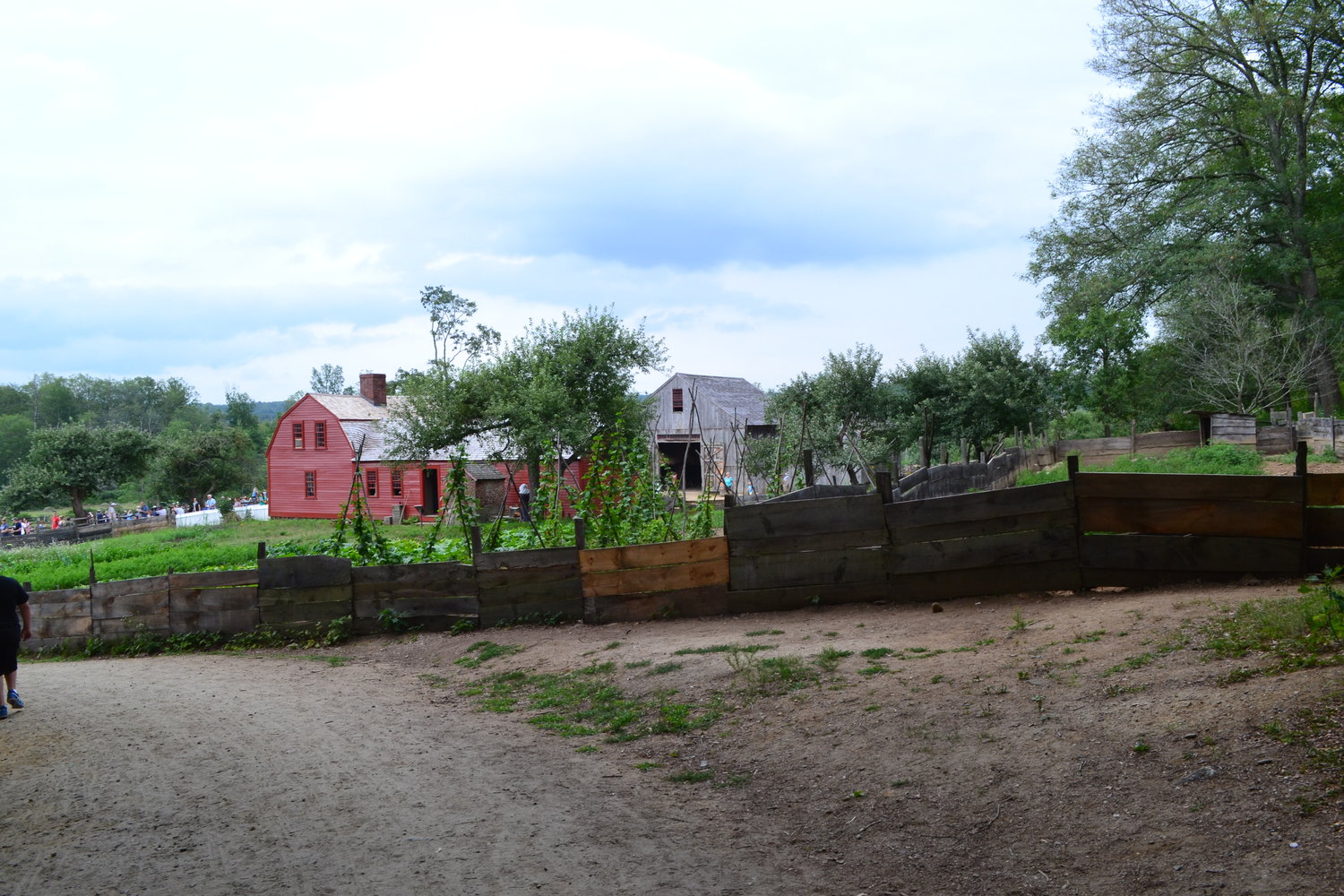

The barn and farmyard provided quite a bit of excitement, especially for the children, in the form of the cutest little cows you ever did see.


The Mill Neighborhood is after the Countryside, if one is following the outer trails. Mills were important to the towns, farms, and shops in early nineteenth century New England. In 1837, historic Sturbridge had three textile mills making over 1.8 million yards of cotton cloth every year. Today the site hosts a covered bridge from Dummerston, Vermont, ca. 1870, a carding mill from South Waterford, Main, ca. 1840, a gristmill built by Old Sturbridge Village in 1938, and a sawmill reproduced by OSV in 1984. Both of the reconstructions were built on the original sites of previous mills. The Gristmill was one of the first buildings constructed at OSV, and was erected on the site of the Wight family’s original gristmill from recycled old timber and new lumber. The millstones and other parts came from the Porter Gristmill in Hebron, Connecticut.

In addition to the quintessential array of historic buildings decked out in period displays, located throughout the site are several traditional Museum Exhibits covering a variety of themes. Being interspersed throughout the history-houses and trade shops they made for an exciting if eclectic mix. Some highlights are “New England’s Changing Landscape," the Glass display, Towne Barn and its display on farming, and the Firearms & Textiles display.




As exciting as the buildings and displays of Old Sturbridge Village are, ultimately I was there for Redcoats and Rebels. It was fun to just walk around and watch the reenactors going about their business, but there were also events taking place throughout the day around the Village, including such delights as “Meet a Calf” at the Freeman Farm, “Reconnoiter with the Light Infantry” outside the Center Meetinghouse, “Broom Making Demonstration” by the Firearms & Textile Exhibit, “Shifts, Stays, & Panniers – what a woman wears!” where we began our day, and “Learn an 18th Century Social Dance with Mistress Stewart" in front of the Bullard Tavern, where we whiled away some time before the Battle.



Both reenactors and visitors participated; Mistress Stewart went over the steps with the couples before letting everyone loose to shuffle and whirl down the line. The more people turned wrong or headed in the opposite direction, the merrier the company became. It’s always fun to share laughs at the beginner’s expense. Especially when they are family.
2:00 saw the “Battle Between Patriots & Redcoats” in the Freeman Farm Fields. Both companies began muster about fifteen minutes before marching out to the farm, we stayed in front of the Center Meetinghouse to watch the American troops.


Of course, staying for the muster meant missing out on the best spots for viewing the battle, and the viewing field and surrounding hilltop were absolutely packed with spectators. Lydia and I decided to seek higher ground and hopefully secure a better view.
This turned out for the best, as we found a space up near the house, where both sides were running, marching, shooting, and storming in short order. It was hot, loud, and so very thrilling.



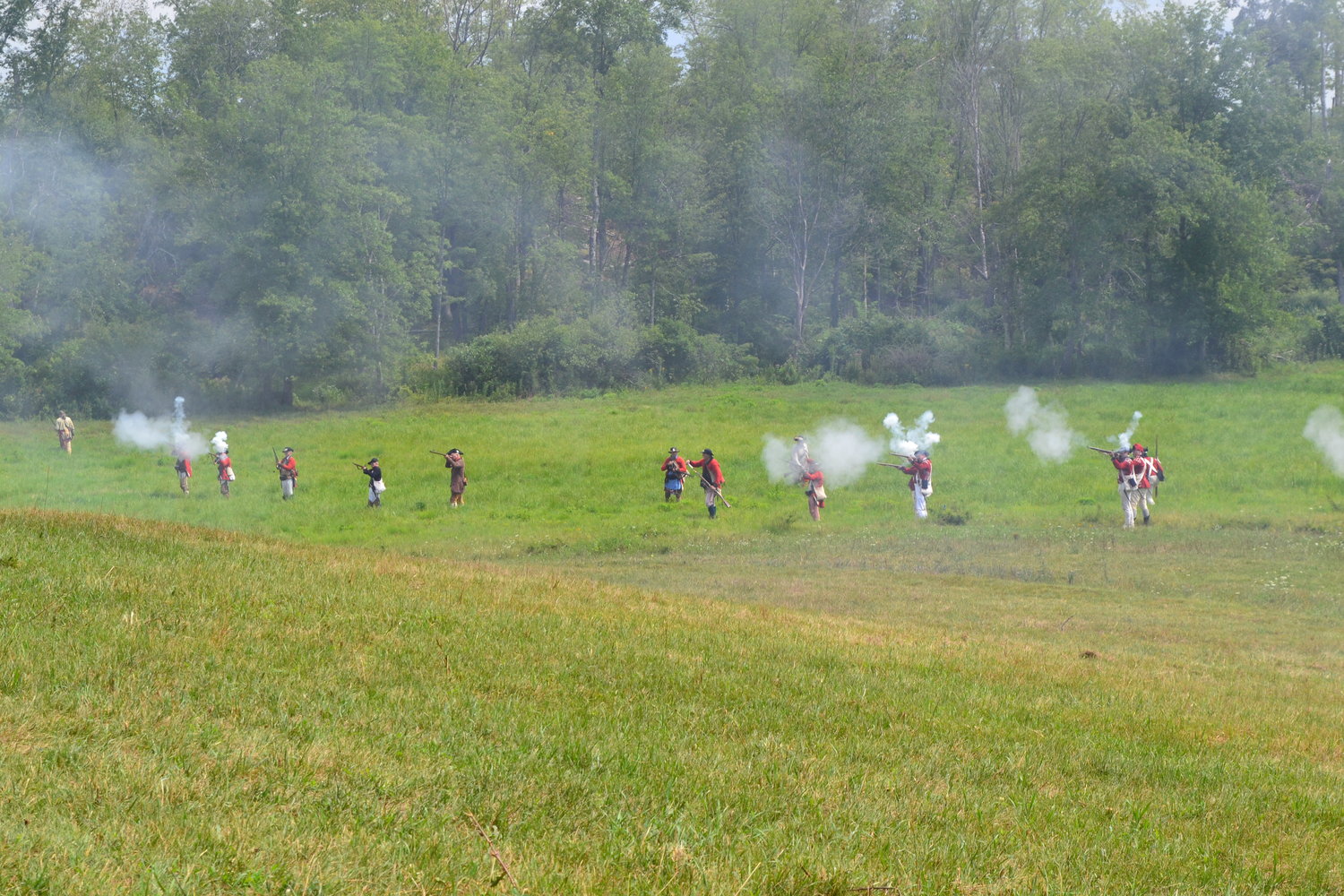
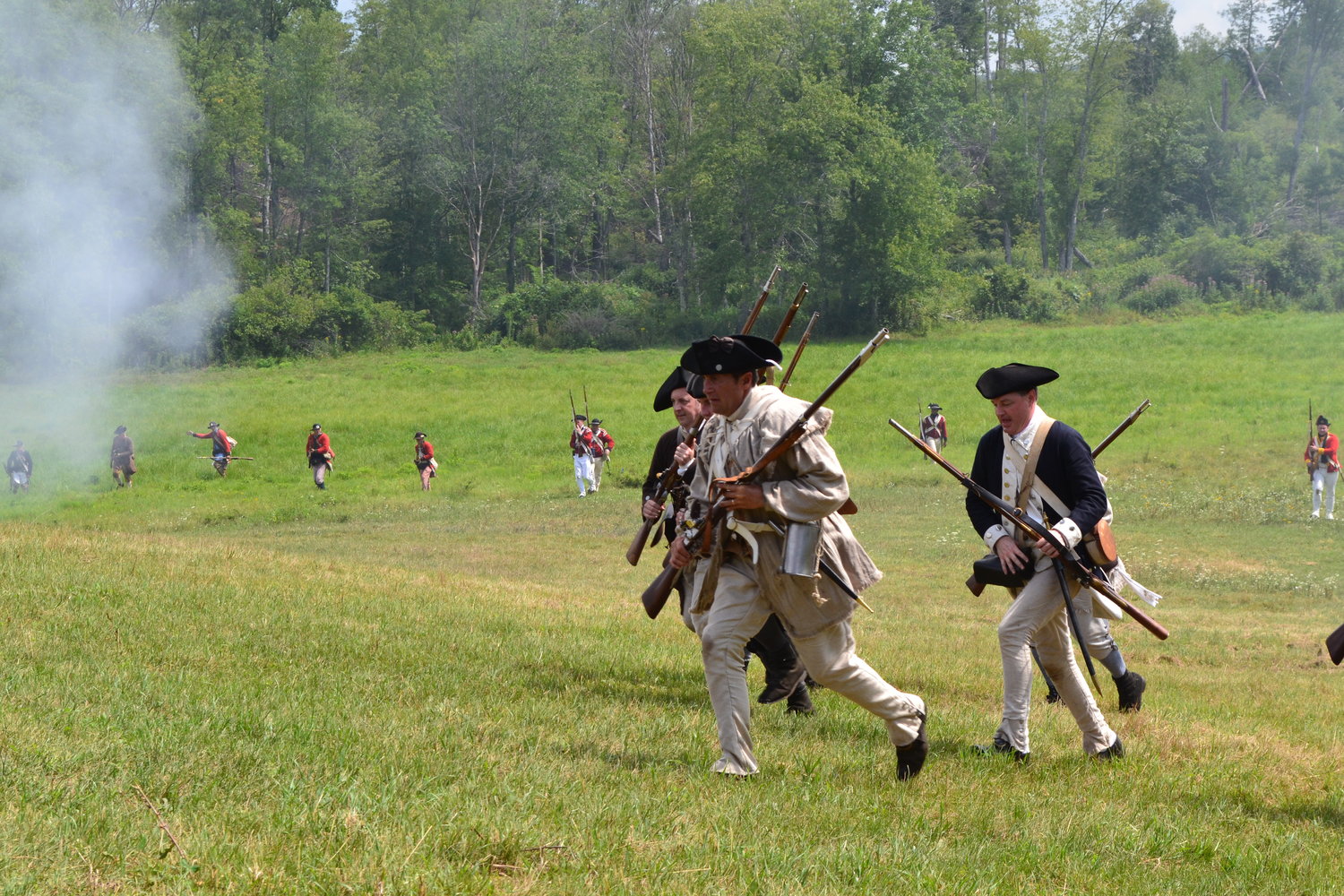
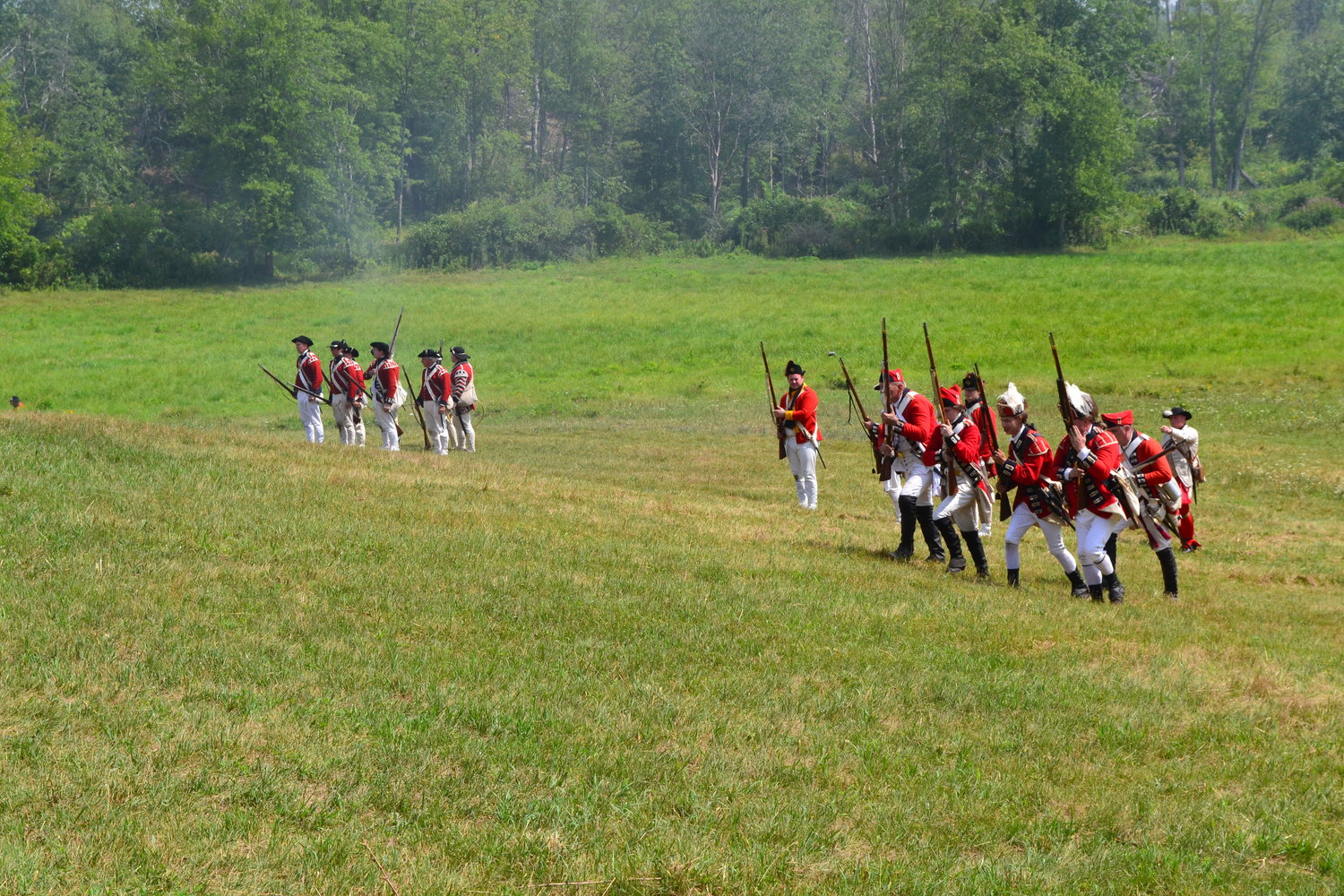
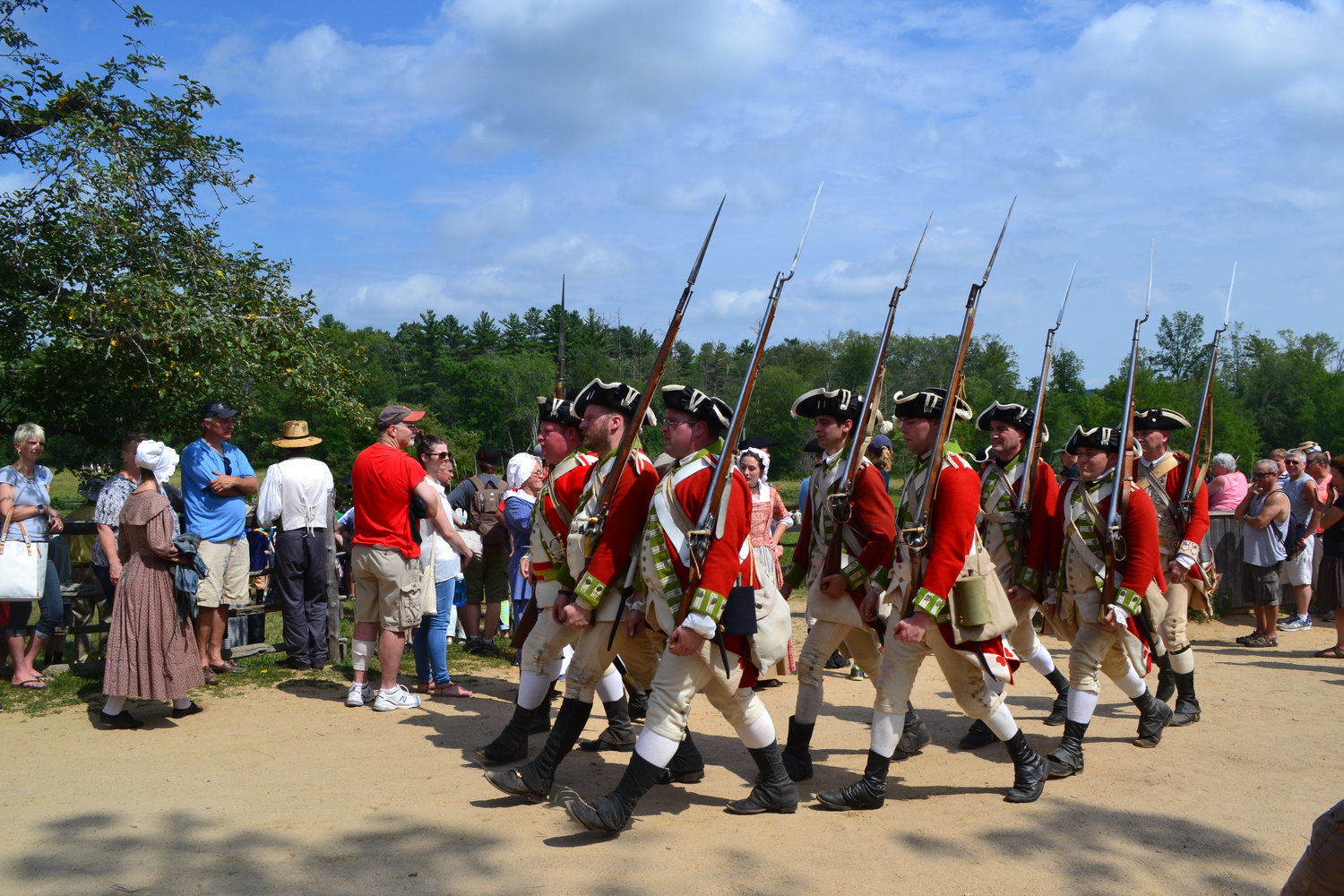
The battle ended with the British taking the hill and surrounding the defeated the Americans, followed by a victory parade by the British to the Central Meetinghouse and a “Declaration of the British of the occupation of OSV.” I believe the second day, Sunday, will see the Americans re-take the hill and oust the British from Old Sturbridge Village, though there is no official “Declaration” of the ousting on Sunday’s event schedule.

The end of the battle didn’t mean the end of the fun, with the last event starting at 7:30 p.m. (“Massed Artillery Barrage” by the Cooper Shop). We chose not to stay for the entire day, as it looked like rain (and rain it did), but we were there long enough to see most of the buildings and wander around a sizeable portion of the campsites. This was the first reenactment I’ve been to (as visitor or participant) that took place in a historic village. Apparently it’s very popular among the reenactors who are invited; many are repeats with entire companies making the trip, and Mr. Obrien believes he knows several hundred of them by name. I enjoyed the setup; making our way down the paths took us past an array of camp sites and buildings, and the wide variety of offerings made for a longer visit than is usually the case at these sorts of things.
I must not be alone in my thinking: There were quite a few visitors there (8 to 10 thousand will visit over the two day event), making the already tight squeeze into the historic buildings even tighter, but it was also fun being a part of the crowds too. A major part of the visitor experience at any of these events is the interaction between the reenactors and the visitors, and Mr. Obrien said that at Redcoats and Rebels it is one of their primary goals. They had a resounding success: Everywhere I turned I saw people engaging with one another and having a great time.

This is just how it should be at Old Sturbridge Village: “The one-on-one experience with the guests is always pretty much at the forefront of everything,” stated Mr. Obrien. It’s so important, in fact, that the Village tailors its hiring policies around personality, and on how potential employees interact with visitors. According to him, the payoff is worth it: “Where else can you work and get instant gratification? You know if you’re connecting right off the bat…. It’s not hard to realize when you’ve connected, or when you’re having one of those really good experiences.”
These good experiences prompt the actualization of OSV’s goals, both for visitors and reenactors. “A big goal of ours is we want people to leave having spurred them to want to know more about something,” said Mr. Obrien. “I think [Redcoats and Rebels] really does build that passion.” A large part of this goal is the work OSV does with reenactors and the hobby, to develop it and to give those groups an opportunity for improvement that otherwise might not attain high-quality levels of accuracy. Mr. Obrien made the Museum’s role in backing the hobby clear, stating “I want the museum to be partially responsible for helping to spur a renaissance within the hobby. Get [the reenactors] on solid footing so there aren’t those issues when everybody ages out, they’re too old, and the next generation isn’t coming in…. I want to keep the museum going and keep the hobby going with this.”
Redcoats and Rebels is an event worthy of appreciation, maintaining its value to engage, educate, and entertain visitors. “If it [didn’t make] sense or we didn’t have a passion to show it here I definitely would be looking for another event. I wouldn’t keep it just to keep it,” said Mr. Obrien. He noted a lot of events suffer after five or seven years, something those in the industry call ‘event fatigue.’ “[Redcoats and Rebels] is on year thirteen,” he smiled, “and we just kind of go with it. It’s still got a long run ahead of it.” Both he and Ms. Coleman shared in the common sentiment felt on staff, as Mr. Obrien put it, “Deep down we all really love this event. I think we’d miss it – we’d hate to see it go.” Staff member Christina Coleman added, “There’s a lot of ‘Redcoats is coming this weekend, we’re not going to get a lot of sleep;’ but there’s also an air of excitement going on.”
I agree that there is an air of excitement present during Redcoats and Rebels: it moves through the buildings, winds along the tree-lined trails, and roles over the undulating fields. It is felt by the staff, the reenactors, and the visitors. This is Redcoats and Rebels, this is Old Sturbridge Village: This is the living history museum, and it is what they do best.

